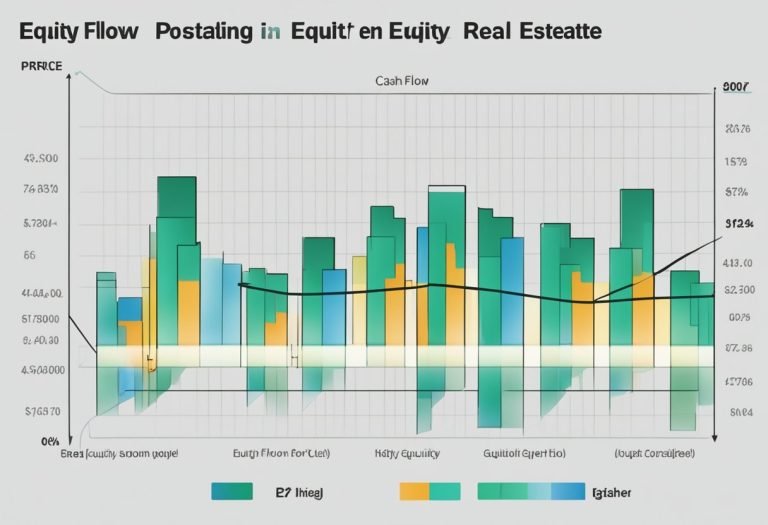Mastering Real Estate Cycles: 6 Key Indicators to Know
How can Mastering real estate cycles help you make better investment decisions?
Understanding real estate cycles can help you make better investment decisions by allowing you to identify trends and predict market conditions. By knowing whether the market is in a boom or bust phase, you can strategically buy or sell properties, maximize profits, and mitigate risks.

Navigating the real estate market is like sailing the open sea; you need to read the signs to harness the winds of prosperity.
As you seek the freedom to make informed decisions, ‘Mastering Real Estate Cycles: 6 Key Indicators to Know’ is your compass. You’ll learn how tracking GDP growth and unemployment rates can reveal the market’s health.
You’ll see how interest rate trends impact your investments and why housing starts matter. By observing rent-to-price ratios, you gain insight into market sustainability, while assessing consumer confidence can be the beacon that signals when to buy or sell.
Understanding these indicators isn’t just about data; it’s about gaining the freedom to navigate the market’s ebbs and flows with confidence. Embrace this knowledge, and you’ll be well-equipped to chart a course to successful real estate investing.
Understanding GDP Growth
https://www.youtube.com/embed/khDAji7dXw0
You’ll often find that GDP growth is a reliable barometer for gauging the health of the real estate market. As you yearn for the freedom to make strategic moves in this market, understanding the ebb and flow of the real estate cycle becomes paramount. GDP growth, along with other economic factors such as interest rates, unemployment rates, and consumer confidence, plays a significant role in shaping the real estate cycle and directly influences the demand for investment property in the real estate industry. It’s a pivotal economic indicator that savvy investors like you watch closely.
When GDP is on the rise, it signals an expanding economy with solid job growth. Jobs are created, incomes rise, and the confidence of both consumers and businesses grows. This positivity feeds into real estate, often resulting in heightened demand for both residential and commercial real estate properties. On the flip side, when GDP contracts, caution prevails. Investments may slow down, and the real estate market can be directly impacted by the state of the general economy, particularly during the recovery phase.

Keeping a keen eye on GDP growth helps you anticipate these shifts, allowing you to navigate the real estate cycle with greater agility. You’re empowered to act when the time’s right, securing opportunities or hedging against potential downturns.
In the quest for real estate success, recognizing and responding to these economic indicators isn’t just smart—it’s essential for maintaining your investment freedom.
Tracking Unemployment Rates
As you monitor the health of the real estate market, consider how unemployment rates shape the landscape.
Higher joblessness can diminish people’s ability to purchase homes, softening the market.

Conversely, robust employment trends typically boost buying power, propelling property demand and values.
Joblessness Impact
Understanding how a single percentage point fluctuation in unemployment rates can significantly alter the real estate landscape helps you anticipate market shifts. The joblessness impact isn’t just a number on a report; it’s a bellwether for the health of the economy and the real estate cycles you navigate.
When fewer people are out of work, they’ve got the freedom to chase their dreams, including buying homes or investing in properties. This drives demand for property skyward.
Conversely, high unemployment can handcuff the market. Without steady incomes, demand plummets, and property values may follow suit.

For the savvy investor, keeping a pulse on these trends isn’t just smart—it’s essential for maintaining the liberty to make moves that resonate with the rhythm of the market’s ebbs and flows.
Rates Predict Buying Power
To gauge your potential buyers’ financial capacity, closely monitor how unemployment rates forecast their ability to invest in real estate. Low unemployment rates typically signal that more people have the means to chase the dream of homeownership, often leading to increased demand and potentially higher property values. However, during the recovery phase, high vacancy rates may counteract this trend and decrease buying power for property owners, particularly in rental markets. Remember, with more folks employed, the chances of them securing a mortgage with low interest rates rise, enhancing their buying power during the recovery phase for property owners in rental markets.
Conversely, when unemployment ticks up, high interest rates can become a greater burden, and the pool of buyers shrinks. It’s a clear sign: job security empowers individuals to make bold moves in the market.
Employment Trends Analysis
By keeping tabs on unemployment trends and national economic trends, you’ll gain valuable insights into the real estate market’s current state and future direction. As unemployment rates fluctuate, so does the potential for real estate investing. When more people are employed, they’ve the freedom to make moves—literally. They’re hunting for homes, pushing demand, and often, rising prices follow. On the flip side, if joblessness climbs, caution may grip the market. Folks might tighten their belts, stalling their home-buying dreams and affecting rental rates. Employment trends analysis is a crucial aspect of understanding the current state of the residential real estate markets and predicting their future direction.

Employment trends analysis is more than just a number-crunching exercise; it’s a freedom-finding mission. It empowers you to anticipate shifts, seize opportunities, and navigate through the ebbs and flows of the market. So, keep a sharp eye on those unemployment rates—they’re your crystal ball into real estate’s future.
Analyzing Interest Rate Trends
You’ve seen how fluctuating interest rates can either fuel or dampen property demand.
Now, it’s crucial to understand how these trends can help you predict market movements.
Rate Impact on Demand
While you track interest rate trends, it’s clear that even slight shifts can significantly influence buyers’ demand for real estate. Understand this: when rates are high, your dreams of freedom through property investment might hit a wall. Expensive loans lead to higher monthly payments, making potential buyers think twice. This, in turn, cools down the real estate markets, possibly causing property prices to stabilize or even dip. Additionally, government policies such as tax deductions, tax credits, or homebuyer programs can also impact demand for real estate by creating incentives for buyers at each stage of the cycle. However, one of the main factors that can greatly influence the housing market cycle is interest rates, particularly during the Hyper Supply stage. It is important to keep an eye on these factors as they can majorly influence the housing market cycle.

On the flip side, lower rates can unlock doors, flooding markets with eager buyers and driving up property prices. Your ability to anticipate these changes gives you the edge. Stay ahead of the game by keeping a close watch on those rates; they’re not just numbers, they’re the heartbeat of the market’s demand.
Predicting Market Movements
To adeptly predict real estate market fluctuations, you’ll need to scrutinize every subtle change in interest rates. Understanding the impact of these rates on real estate prices is crucial for investment freedom. When rates drop, it’s your signal; more people can afford mortgages, potentially driving up demand and prices.
Conversely, if you’re watching the yield curve invert—a telltale sign of rising rates—brace for a possible cooling market. Always consider government subsidies, too. These can offset high-interest environments, keeping the market accessible.
Monitoring Housing Starts
As you monitor housing starts, you’re tapping into a vital indicator that sheds light on the real estate market’s supply dynamics and potential economic trends. Housing starts reveal much about the health of residential real estate and can signal manifold investment opportunities.

When housing starts rise during the expansion phase, it often means builders are bullish about demand. This uptick suggests an active market where freedom of choice thrives for consumers and investors alike. You’re looking at a landscape ripe with options—a place where you can navigate towards properties that align with your aspirations and financial strategies, potentially leading to a higher market value. Additionally, new construction projects are plentiful during this phase, providing even more opportunities for investment and growth.
On the flip side, a dip in housing starts could hint at a tightening market for real estate investors. But don’t view this as a stop sign. Instead, see it as a strategic signpost, guiding you to exercise due diligence and pay close attention to indicators such as housing demand and renter activity. This will help you create a comprehensive investment plan and capitalize on the key signals of a market that is beginning to gain momentum in different phases. Enjoy attractive pricing while also monitoring housing starts and signs of recovery.
Keep in mind, housing starts aren’t just numbers; they’re a reflection of broader economic forces—from interest rates to policy changes. Deciphering these trends arms you with the foresight to make informed decisions, ensuring your real estate ventures stay aligned with the pulse of the market’s ebbs and flows.
Stay vigilant, and let the data chart your course to freedom in the real estate realm.

Observing Rent-to-Price Ratios
Examine rent-to-price ratios closely to gauge the true potential of your real estate investments. This metric is essential—it’s your compass in a sea of market fluctuations, guiding you towards freedom and away from financial shoals. By observing rent-to-price ratios, you’ll be able to discern which residential rental units offer the liberty of solid returns as opposed to those that could potentially anchor your portfolio in unprofitable waters.
With property values and rents continuing to rise in many areas, it’s vital to keep a steady watch on rent growth. A high rent-to-price ratio can be a siren call for investors, suggesting that rental income is likely to cover purchase and maintenance costs, leaving room for profit. Conversely, a low ratio might signal that the property’s cost outweighs its earning power, constraining your financial freedom.
Remember, this indicator isn’t static. It shifts with market tides. So, make it a habit to analyze these ratios periodically. It’s this vigilant observation that can lead to strategic choices, enabling you to navigate through the cycles of real estate with the confidence and freedom you desire.
Stay informed, stay agile, and let the rent-to-price ratios illuminate the path to your investment success.

Assessing Consumer Confidence
Building on your understanding of rent-to-price ratios, you’ll find that assessing consumer confidence is equally crucial for navigating the ebb and flow of the real estate market. As you seek the freedom to make savvy, successful real estate investments, it’s essential to tune into the public’s buying sentiment. High consumer confidence often signals a ripe environment for robust sales and potentially higher property values, whereas low confidence suggests a market slowdown, with more people hesitant to make big moves.
Paying attention to consumer confidence isn’t just about watching numbers fluctuate; it’s about understanding the human emotions driving the market. Remember the great recession? It was a stark reminder that when confidence plummets, the real estate world can grind to a near standstill. Conversely, when optimism reigns, the market thrives.
To stay ahead, leverage this indicator by keeping an eye on employment trends, stock market performance, and the broader economic narrative. These elements can give you a heads-up on potential shifts, allowing you to pivot your strategies and maintain your edge.
Frequently Asked Questions
What Are the Economic Components of the Real Estate Cycle?
You’ll see real estate cycles influenced by GDP growth, employment trends, and consumer confidence. These components guide your investment freedom, signaling when to buy or sell for optimal financial gains.
What Are the 4 Stages of the Real Estate Cycle?
You’ll navigate the real estate cycle’s four stages: recovery, where market growth rekindles; expansion, marked by bustling construction activity; hyper-supply, when housing market trends peak; and recession, prompting revised investment strategies.
What Are Indicators in Real Estate?
You’re navigating uncharted waters when you ignore market sentiment, construction trends, and interest rates as real estate indicators. They’re your compass to freedom in the property market — don’t sail without them.
What Are the Real Estate Cycle Quadrants?
The real estate cycle quadrants reflect market psychology, guiding your investment strategies. They’re shaped by zoning impacts, predicting when you’ll enjoy freedom from market downturns and capitalize on growth opportunities.
Conclusion
You’re now equipped with a compass to navigate the real estate odyssey, akin to Odysseus charting the Aegean.
By heeding the siren call of GDP growth and unemployment rates, scrutinizing the winds of interest rates, charting the construction constellations with housing starts, balancing the scales of rent-to-price ratios, and interpreting the consumer confidence oracle, you’ll sail closer to the shores of investment triumph.
Master these indicators, and you’ll not just survive but thrive in the cyclical saga of real estate.
You Might Also Like…
10 Science-Backed Economic Indicators Essential For Spotting Real Estate Cycles








2 Comments
Comments are closed.